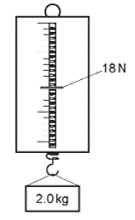Quiz Summary
0 of 10 Questions completed
Questions:
Information
You have already completed the quiz before. Hence you can not start it again.
Quiz is loading…
You must sign in or sign up to start the quiz.
You must first complete the following:
Results
Results
0 of 10 Questions answered correctly
Time has elapsed
You have reached 0 of 0 point(s), (0)
Earned Point(s): 0 of 0, (0)
0 Essay(s) Pending (Possible Point(s): 0)
| Average score |
|
| Your score |
|
Categories
- Not categorized 0%
| Pos. | Name | Entered on | Points | Result |
|---|---|---|---|---|
| Table is loading | ||||
| No data available | ||||
- 1
- 2
- 3
- 4
- 5
- 6
- 7
- 8
- 9
- 10
- Current
- Review
- Answered
- Correct
- Incorrect
-
Question 1 of 10
1. Question
1 point(s)Which statement about the masses and weights of objects on the Earth is correct?
CorrectIncorrect -
Question 2 of 10
2. Question
1 point(s)The table shows the weight in newtons of a10 kg mass on each of four planets.
\[
\begin{array}{|c|c|}
\hline \text { planet } & \text { weight of a } 10 \mathrm{~kg} \text { mass/N } \\
\hline \text { Earth } & 100 \\
\text { Jupiter } & 250 \\
\text { Mercury } & 40 \\
\text { Venus } & 90 \\
\hline
\end{array}
\]The diagram shows a force meter (spring balance) being used.
 On which planet is the force meter (spring balance) being used?CorrectIncorrect
On which planet is the force meter (spring balance) being used?CorrectIncorrect -
Question 3 of 10
3. Question
1 point(s)Which property of a body can be measured in newtons?
CorrectIncorrect -
Question 4 of 10
4. Question
1 point(s)A cup contains hot liquid. Some of the liquid evaporates as it cools. What happens to the mass and to the weight of the liquid in the cup as it cools?
\[
\begin{array}{|c|c|c|}
\hline & \text { mass } & \text { weight } \\
\hline \text { A } & \text { decreases } & \text { decreases } \\
\text { B } & \text { decreases } & \text { stays the same } \\
\text { C } & \text { stays the same } & \text { decreases } \\
\text { D } & \text { stays the same } & \text { stays the same } \\
\hline
\end{array}
\]CorrectIncorrect -
Question 5 of 10
5. Question
1 point(s)Two blocks of metal \(X\) and \(Y\) hang from spring balances as shown in the diagram.
 What does the diagram show about \(X\) and \(Y\) ?CorrectIncorrect
What does the diagram show about \(X\) and \(Y\) ?CorrectIncorrect -
Question 6 of 10
6. Question
1 point(s)The graph shows how weight varies with mass on planet \(\mathrm{P}\) and on planet \(\mathrm{Q}\).
 An object weighs \(400 \mathrm{~N}\) on planet \(\mathrm{P}\). The object is taken to planet \(\mathrm{Q}\).
An object weighs \(400 \mathrm{~N}\) on planet \(\mathrm{P}\). The object is taken to planet \(\mathrm{Q}\).
Which row is correct?\[
\begin{array}{|c|c|c|}
\hline & \begin{array}{c}
\text { mass of object } \\
\text { on planet Q/kg }
\end{array} & \begin{array}{c}
\text { weight of object } \\
\text { on planet Q/N }
\end{array} \\
\hline \text { A } & 40 & 200 \\
\text { B } & 40 & 400 \\
\text { C } & 80 & 200 \\
\text { D } & 80 & 400 \\
\hline
\end{array}
\]CorrectIncorrect -
Question 7 of 10
7. Question
1 point(s)Which statement about mass and weight is correct?
CorrectIncorrect -
Question 8 of 10
8. Question
1 point(s)A metal block is heated until it is completely melted. It is then allowed to solidify. What happens to the mass of the metal during the changes of state?
\[
\begin{array}{|c|c|c|}
\hline & \begin{array}{c}
\text { mass during } \\
\text { melting }
\end{array} & \begin{array}{c}
\text { mass during } \\
\text { solidification }
\end{array} \\
\hline \text { A } & \text { decreases } & \text { increases } \\
\text { B } & \text { increases } & \text { decreases } \\
\text { C } & \text { increases } & \text { stays constant } \\
\text { D } & \text { stays constant } & \text { stays constant } \\
\hline
\end{array}
\]CorrectIncorrect -
Question 9 of 10
9. Question
1 point(s)Which statement about the mass and the weight of an object is correct?
CorrectIncorrect -
Question 10 of 10
10. Question
1 point(s)An object always has mass but does not always have weight. What must be present and acting on the mass for it to have weight?
CorrectIncorrect
